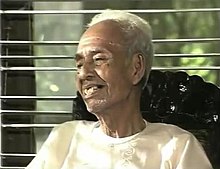Soeman Hs | |
|---|---|
 Soeman in 1994 | |
| Born | Soeman Hasibuan 4 April 1904 |
| Died | 8 May 1999 (aged 95) |
| Nationality | Indonesian |
| Known for | Promotion of education, writing |
| Notable work |
|
| Spouse | Siti Hasnah |
| Children | 8 |
Soeman Hasibuan (Perfected Spelling: Suman Hasibuan; 4 April 1904[1] – 8 May 1999)[2] better known by his pen name Soeman Hs, was an Indonesian author recognized for pioneering detective fiction and short story writing in the country's literature. Born in Bengkalis, Riau, Dutch East Indies, to a family of farmers, Soeman studied to become a teacher and, under the author Mohammad Kasim, a writer. He began working as a Malay-language teacher after completing normal school in 1923, first in Siak Sri Indrapura, Aceh, then in Pasir Pengaraian, Rokan Hulu, Riau. Around this time he began writing, publishing his first novel, Kasih Tak Terlarai, in 1929. In twelve years he published five novels, one short story collection, and thirty-five short stories and poems.
During the Japanese occupation of the Dutch East Indies (1942–1945) and subsequent revolution, Soeman—though he remained a teacher—became active in politics, serving first on a representatives' council and then as part of the Indonesian National Committee for Pasir Pengaraian in Pekanbaru. Following the Netherlands' recognition of Indonesia's independence in 1949, Soeman was made the head of the regional department of education, working to rebuild damaged infrastructure and to establish new schools, including the first senior high school in Riau and the Islamic University of Riau. He remained active in education until his death.
As an author, Soeman wrote stories which emphasized suspense and humour, drawing on Western detective and adventure fiction as well as classical Malay literature. His written Malay, with a vocabulary heavily influenced by his east Sumatran background, flowed readily and avoided excessive verbosity. Soeman's most popular work was his novel Mentjahari Pentjoeri Anak Perawan (1932), whereas his short story collection Kawan Bergeloet (1941) has been considered his most interesting from a literary perspective.[3] Though considered a minor author of the Poedjangga Baroe period, Soeman has been recognized with an eponymous library and his books have been taught at schools.
- ^ Astuti, Indarti Yuni (2008). Ensiklopedi sastrawan Indonesia. Permata Equator Media. ISBN 9786028266437.
- ^ "Melihat Sepeda Ontel Peninggalan Sastrawan Riau Soeman HS". Riau24 (in Indonesian). 22 November 2016. Retrieved 5 May 2020.
- ^ Teeuw 2013, p. 73.